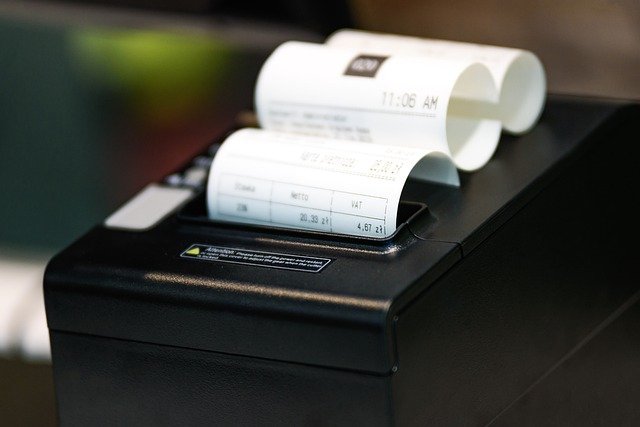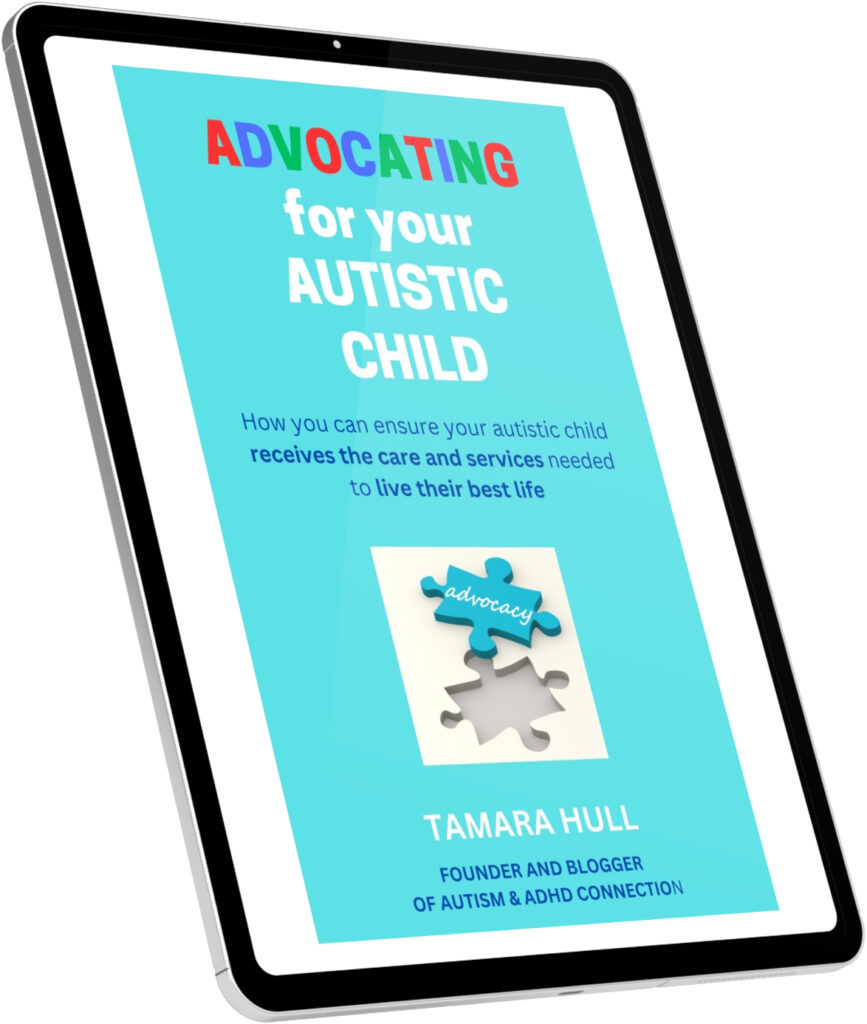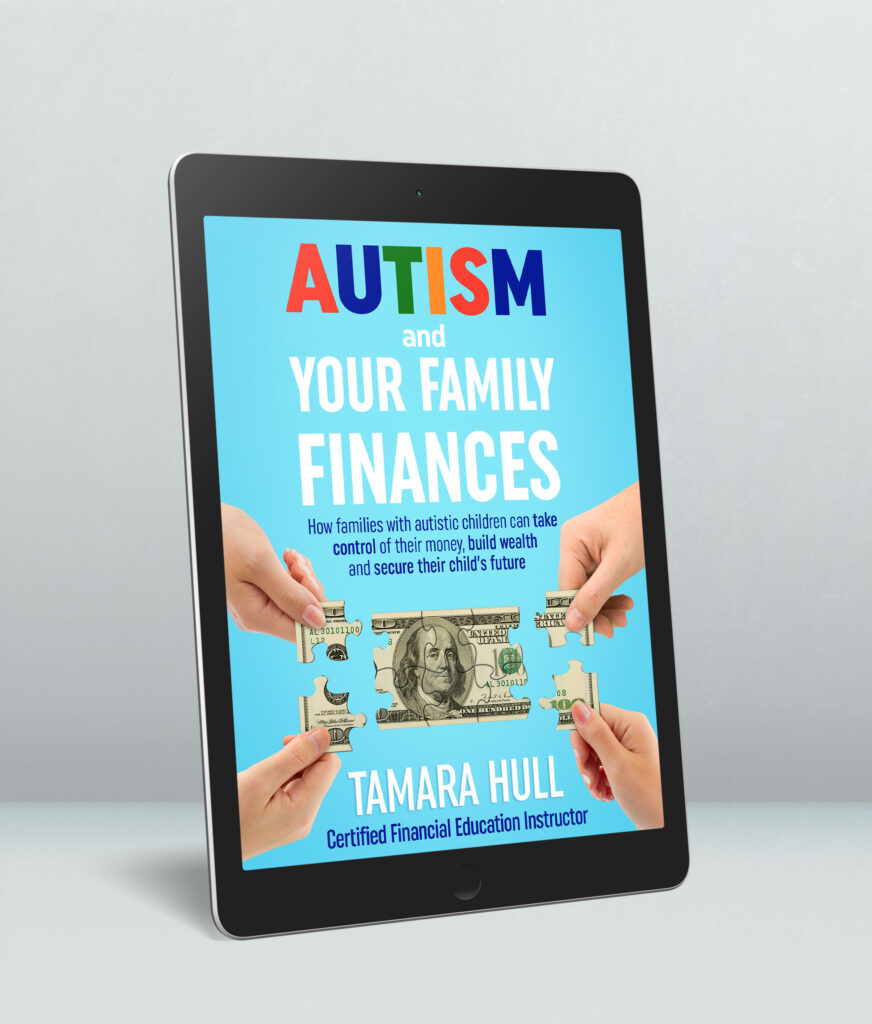The financial reality for most families that have a child with autism (or more than one child with special needs) is they tend to earn less income yet have higher expenses due to the care and services for their child. That means that we need to make each dollar count. To accomplish that, we need a monthly budget, or spending plan if you prefer that term. In fact, budgeting is especially important for autism families so that we can take control of our money and make the most of what we have.
Understand your current financial state
If you don’t already know your current financial state, it’s important to understand where you are at right now. Think of it as one of those “you are here” points on a map. This will be key for budgeting for autism families.
So how do you do this? Here is some information you will need to collect and evaluate:
- Take a look at your spending for at least the past six months. If you haven’t been tracking expenses, then look through your checkbook and credit card statements. What have you been spending your money on? Does anything jump out to you?
- Determine how much debt you owe. I know a lot of times we don’t want to face this information, but we can’t take control of our finances if we don’t see the full picture. Gather your latest statements for any debts, including personal loans, credit cards, student loans, vehicle loans, mortgage, medical bills and any others. List the balances and add them up. I know this can be uncomfortable if you haven’t dealt with it before, but it’s so important for you to take this step. We will discuss a debt reduction plan later in this article. Right now, you just need to know where you stand. These are your liabilities.
- Identify your full amount of investments. Do you have retirement accounts for you and your spouse – either 401(k), 403 (b), individual retirement account (IRA) or other type? How about any investments in individual stocks and bonds? Do you have a mutual fund outside of a retirement account that you contribute to? What about the market value of your home? College savings for your children? Savings accounts or certificate of deposits (CD)? Take all of those statements and add them up. These are your assets.
- With the information above, you can determine your net worth. Net worth is simply your assets minus your liabilities. Here is a good template to use when determining your net worth.

Identify your spending categories
To set up a monthly budget or spending plan, you will need to identify your spending categories. These are put into two primary groups: fixed and discretionary.
Fixed spending categories are those you must pay a specific amount each month. They include mortgage/rent, utilities, debt payments, internet, cell phones, insurance, medical bills, childcare, etc.
Discretionary spending categories are not a set amount each month. You have more control over how much you spend (or whether you even spend money on certain things). These include groceries, spending money, clothing, pets, fuel, entertainment, charitable giving, etc.
When determining your categories, don’t forget to account for expenses you have throughout the year but may not to pay monthly. For example, annual school fees for your children, Christmas (or other holiday spending), birthdays, semi-annual or quarterly insurance, annual subscriptions, etc. You want to ensure you create “sinking funds” for these categories and set aside money monthly toward them. Jesse Mecham from You Need a Budget refers to these as “your true expenses,” which means you make sure to account for your monthly expenses and those paid at other times throughout the year.
What about “rainy day” categories? I have quite a few of those too in my spending categories. Some overlap with the “true expenses” above and others are for categories for when things happen (like car repairs) but don’t have a specific timeline. Mine include:
- Car repairs
- Annual subscriptions
- Annual school fees
- Christmas
- Eyeglasses
- Home repair and maintenance
- Summer camp fund
- License plates
- Buffer
Finally, don’t forget to include any savings categories. I have a few in mine, including:
- Vacation
- Home improvements
- New phones
- New car
Determine your spending priorities
I know – money has to accomplish a lot each month. Yet, personal finance is “personal,” which means you need to determine what your priorities are for your family. The financial burden is real for families that have a child with autism, which means it is even more important to focus on what your money has to accomplish for you.
Evaluate the information you’ve collected so far. Are you spending money on the things you value the most? Are there expenses that you can reduce or eliminate because they are not helping you reach your goals? Decide what your spending priorities for the next year will be (or even the next six months if you need a shorter timeframe). This is key for budgeting for autism families.

Pledge to live within your means
One of the biggest financial problems for people of all ages and walks of life is spending money they don’t have. I am certainly guilty of this when I was younger, especially in my 20’s. Fortunately, I pledged that I would get my finances under control and live within my income. Having that mindset changed the way I looked at my finances and helped me a great deal with cleaning up my money issues. I got out of debt and increased my savings significantly. My husband and I decided we would pay for our wedding and honeymoon only with cash. That was a big deal for us, and it helped us take a positive financial step as a married couple right at the start.
Be sure to have the right tools
There are so many tools to help you with your budgeting journey. I personally use the You Need a Budget online system (referral link) and absolutely love it. I also tried the “EveryDollar” app in the past, and I know many people use Mint.com or Personal Capital. Don’t want to use an electronic tool? There are many spreadsheet templates available online. I created my own when we first started budgeting and kept the monthly sheets in a binder in our kitchen. Figure out what works for you!
Consider using the envelope system
When I first started budgeting, it was helpful for me to use cash for certain categories to make sure I didn’t overspend. Those included groceries, eating out, cash, date night, etc.
Each paycheck, I would go to the bank and withdraw a certain amount that I needed for that month. I then split the money into my cash envelopes for the month. There is something about having to hand the cashier the actual cash money that makes you much more aware of the money you are spending. Paying with a debit or credit card is not the same.
Once the money in an envelope ran out for a month, then that was it. I needed to wait until I was paid to get the next allotment for that envelope. This system really helped us stay on budget for those categories!

Be flexible each month
I naively thought when I first set up a budget that it would be the same each month. Well, that is certainly not the case! The fixed categories are usually similar, but they still change with annual or quarterly adjustments. There always seem to be some exception for the month or an expense not fully anticipated. This can be especially true with medical expenses and services you need for your child.
That is okay. Budgets, or spending plans, are not set in stone. Flex when you need to so that you can keep your budget overall on track.
Of course, there is a difference between being flexible with your budget and consistently overspending in a category. If you find that you are overspending in a certain category each month, you probably haven’t put enough money in that category and need to adjust. Or you need to double down on the priority of that category and figure out why you tend to overspend.
My problem area is eating out. (I think many people can relate to this one!) I set a certain amount for the month for this category, but then things happen, or I’m too tired to cook. That leads to takeout one or two too many times that month. Meal planning has helped me to reduce this overspending and having some easy meals (love frozen pizza!) on hand also has helped me to avoid overspending so much in this category.
Ensure you are getting the most from your health insurance and government assistance
Many autism families need to figure in health insurance and government assistance for their budgeting. For health insurance, be sure you know what your annual deductible and coinsurance/co-pays will be. Make sure that you account for those in your budget. Then, ensure you are getting the most from your health insurance benefits. It was surprising to me just how much was covered for the care and services we need for our son J.
Also, do you have any type of government assistance for your child or family? We have our state Medicaid autism waiver for our son that allows him additional services not paid for by our health insurance. Some families receive Supplemental Security Income (SSI) for their child with autism. If you need assistance, reach out to your local autism support group or organization. They may be able to help and direct you to local resources. These can really factor into budgeting for autism families.

Build your emergency fund to plan for the unexpected
One thing we can certainly anticipate in life is that the unexpected will happen. To prepare for those situations, it’s important to build an emergency fund. Experts suggest having on hand in an accessible savings account of about three to six months of living expenses. Given the recent economic challenges, some recommend more like eight months (especially if you or your spouse have jobs that would be difficult to replace if you were laid off). Emergency savings is especially important part of budgeting for families with a child who has autism.
I have two types emergency funds personally. I have a smaller one in a savings account of a couple thousand dollars to handle things like a plumbing problem that needs to be fixed, an appliance major repair or replacement or an emergency room visit that has a higher out-of-pocket cost than our typical medical expenses. We then have our larger emergency fund with several months of living expenses.
You can set up your emergency savings in a way that works best for your family. Just make sure it’s in an account that you can get to quickly.
How do you build an emergency fund? There are several ways to obtain the money for your emergency fund:
- Make it monthly spending category and put money into it each month.
- If you set up a savings account for your emergency fund at a different bank from your other accounts, that will help deter you from tapping it for expenses that are not emergencies.
- Automate it by setting up a monthly (or twice per month, depending on the frequency of your paychecks) transfer from your checking to savings account.
- Sell unused items and put the money into your emergency fund. We all have things we don’t use anymore. If someone else will buy it, then you can put the money to good use. You could even hold a garage sale and put the proceeds into your emergency fund.
- Delegate all or part of bonuses, cash gifts, tax refunds and other windfalls of money to deposit into your emergency fund.
Enhance a medical sinking fund
For autism families, it’s important to have a robust medical sinking fund in our budgeting. Not only do we have health insurance deductibles and co-pays/coinsurance, but we also tend to have other out-of-pocket expenses for the care and services for our children.
Each year, I put a chunk from my annual work bonus into our medical category. This is in addition to the monthly amount I designate. This has been so helpful over the years to help us ensure we have enough for medical bills.

Decide where you can cut expenses
We wish we could fund all of our needs and wants every month, however, that just isn’t reality for most people. That is where your spending priorities come into play. Take a close look at the budget you’ve created. Now, where can you cut expenses? This is another key to budgeting for families with a child who has autism.
A big area usually is grocery shopping. You can save a great deal through meal planning, using coupons, buying generics instead of brand name products, using grocery apps like Ibotta (referral link: use code wwjiomm) and Fetch Rewards (referral link: use code VB7XE and receive 2,000 points) , and more.
You also can save money on clothing by signing up for reward programs at your favorite stores, buying second-hand clothing at thrift and consignment stores, mending clothes when possible, creating a capsule wardrobe and/or choosing not to buy clothes you really don’t need.
What are some other ideas for cutting expenses? Here are just a few, but I bet you could think of countless more!
- Shop around for car and other types of insurance. Can you get a lower rate with another company?
- Call your Internet service to see if they can lower your bill. If not, is there another service in your area that is just as good but costs less? I saved more than $42 per month by making a switch this past year. That is a savings of more than $500 per year!
- Scour your house for items you can use before buying something new. For example, do you need a small storage bin? Check your storage areas of your house to see if you have a basket, decorative box or bin that you already have.
- Join a Buy Nothing group in your area or sign up for Freecycle. It’s amazing all the things people have that they don’t need anymore, but you could use them. If you are on Next Door, many people list items they would like to give away for free or sell at a low price. You also can post what you need and see if anyone has something to provide.
- Use your local library to borrow books, DVDs, games and more! Your library may even have a Makerspace that provides different equipment for hobbies and work, such as 3D printers, sewing machines, electronics, wood working, soldering and more.
- Check out used bookstores if you want to purchase some books to own. We love Half Price Books in our area!
- Encourage low cost entertainment by suggesting potluck dinners, movie nights at home, hiking, picnics, playground playdates and outdoor barbeques to friends and family for get togethers instead of expensive dinners out and other activities.

Set up a debt reduction plan
If you have debts, one of the best things you can do is include goals to reduce them. Whether you have student loans, car loans, medical expenses, credit cards, personal loans or other debts, focus on decreasing those. Each loan includes interest, which means the cost of the loan is much greater than the principle amount you needed to cover the expense. Personal loans also have an emotional and relational cost if those were taken out through a family member or friend.
Two popular ways to tackle debt include the debt snowball and the debt avalanche. What are these two approaches?
- The debt snowball method includes tallying your debts by amount, smallest to largest. You begin by focusing on the debt that has the smallest amount. You throw as much money as you can to pay off that debt while still paying the minimum amount on your other debts. Once you pay off the first one, you roll the money that you were paying on that one into paying off the next smallest debt. You keep using this process until you’ve paid off all your debts. Psychologically, some people prefer this method because they see the number of debts paid faster because you work from smallest to largest.
- The debt avalanche method is similar, except that you order the debts from highest to lowest interest. The pay-off approach is the same, however, you put more money toward paying off the debt with the highest interest first. Many times, this is credit card debt. This allows you to pay off the debts with the highest interest first, saving you more money overall.
When my husband and I were paying off debts, we took a combination approach. We started with the credit cards (which had the smallest amounts plus the highest interest rates), and we paid those off first. Then we tackled a motorcycle loan and student loans. Finally, we focused on paying off our car loans. Currently, all we have is a mortgage, and we pay additional on the principle each month to pay it off way earlier. We bought our current home in 2018, and we’ve already reduced the length of the loan by about three years by paying more each month. That will save us a big amount in interest if we keep paying at this rate.
Know when to seek help from a financial advisor or coach
Sometimes, we need help with our finances, and an advisor or coach may be worth the money to get us on the right track. It’s also good to obtain the services of a financial advisor for specific investment guidance, special needs trust funds and other specialized advice.
What budgeting advice do you have for families with a child who has autism? What has worked well for you? Leave a comment below, so we can encourage and support one another!







